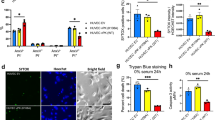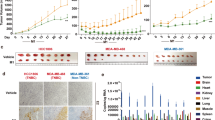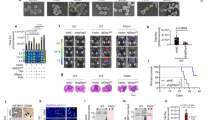Abstract
Attenuated, replication-competent, oncolytic herpes simplex virus type 1 (HSV-1) are effective at infecting and lysing many human malignancies in preclinical studies. Nectin-1 is a cell-surface receptor for HSV-1 envelope glycoprotein D (gD) that also forms a component of intercellular adherens junctions (AJs). We sought to determine if the disruption of AJs in squamous cell carcinoma (SCC) through calcium depletion could be utilized to increase nectin-1 exposure and enhance HSV therapy. NV1023 is a single copy γ134.5-deleted, lacZ-expressing, oncolytic HSV-1. Calcium depletion caused cell separation and increased nectin-1 expression for three SCC cell lines growing at confluence. NV1023 viral entry, soluble gD protein binding and NV1023 cytotoxicity were all significantly enhanced for these cell lines at low calcium conditions. The increase in NV1023 entry at low calcium conditions was abrogated by nectin-1 antibody blockade. Murine SCC flank tumors treated with ethylenediaminetetraacetic acid (EDTA) showed increased nectin-1 expression and increased susceptibility to NV1023 infection. Combined NV1023 and EDTA intratumoral injections demonstrated significantly enhanced tumor regression as compared to NV1023 alone. These findings establish, as proof-of-principle, that herpes viral receptor expression may be modulated on cancer cells to enhance oncolytic therapy. This strategy might have future application toward improving therapy with a variety of herpes vectors.
This is a preview of subscription content, access via your institution
Access options
Subscribe to this journal
Receive 12 print issues and online access
$259.00 per year
only $21.58 per issue
Buy this article
- Purchase on Springer Link
- Instant access to full article PDF
Prices may be subject to local taxes which are calculated during checkout






Similar content being viewed by others
References
Martuza RL, Malick A, Markert JM, Ruffner KL, Coen DM . Experimental therapy of human glioma by means of a genetically engineered virus mutant. Science 1991; 252: 854–856.
Mineta T, Rabkin SD, Yazaki T, Hunter WD, Martuza RL . Attenuated multi-mutated herpes simplex virus-1 for the treatment of malignant gliomas. Nat Med 1995; 1: 938–943.
Kooby DA, Carew JF, Halterman MW, Mack JE, Bertino JR, Blumgart LH et al. Oncolytic viral therapy for human colorectal cancer and liver metastases using a multi-mutated herpes simplex virus type-1 (G207). FASEB J 1999; 13: 1325–1334.
Toyoizumi T, Mick R, Abbas AE, Kang EH, Kaiser LR, Molnar-Kimber KL . Combined therapy with chemotherapeutic agents and herpes simplex virus type 1 ICP34.5 mutant (HSV-1716) in human non-small cell lung cancer. Hum Gene Ther 1999; 10: 3013–3029.
Walker JR, McGeagh KG, Sundaresan P, Jorgensen TJ, Rabkin SD, Martuza RL . Local and systemic therapy of human prostate adenocarcinoma with the conditionally replicating herpes simplex virus vector G207. Hum Gene Ther 1999; 10: 2237–2243.
Cozzi PJ, Malhotra S, McAuliffe P, Kooby DA, Federoff HJ, Huryk B et al. Intravesicular oncolytic viral therapy using attenuated, replication-competent herpes simplex viruses G207 and NV1020 is effective in the treatment of bladder cancer in an orthotopic syngeneic model. FASEB J 2001; 15: 1306–1308.
Wong RJ, Kim SH, Joe JK, Shah JP, Johnson PA, Fong Y . Effective treatment of head and neck squamous cell carcinoma by an oncolytic herpes simplex virus. J Am Coll Surg 2001; 193: 12–21.
Yu Z, Eisenberg DP, Singh B, Shah JP, Fong F, Wong RJ . Treatment of aggressive thyroid cancer with an oncolytic herpes virus. Int J Cancer 2004; 112: 525–532.
Markert JM, Medlock MD, Rabkin SD, Gillespie GY, Todo T, Hunter WD et al. Conditionally replicating herpes simplex virus mutant, G207 for the treatment of malignant glioma: results of a phase I trial. Gene Therapy 2000; 7: 867–874.
Rampling R, Cruickshank G, Papanastassiou V, Nicoll J, Hadley D, Brennan D et al. Toxicity evaluation of replication-competent herpes simplex virus (ICP 34.5 null mutant 1716) in patients with recurrent malignant glioma. Gene Therapy 2000; 7: 859–866.
Kemeny N, Brown K, Covey A, Kim T, Bhargava A, Brody L et al. Phase 1, open-label, dose-escalating study of a genetically engineered herpes simplex virus, NV1020, in subjects with metastatic colorectal carcinoma to the liver. Hum Gene Ther 2006; 17: 1214–1224.
Wong RJ, Patel SG, Kim S, DeMatteo RP, Malhotra S, Bennett JJ et al. Cytokine gene transfer enhances herpes oncolytic therapy in murine squamous cell carcinoma. Hum Gene Ther 2001; 12: 253–265.
Wong RJ, Joe JK, Kim SH, Shah JP, Horsburgh B, Fong Y . Oncolytic herpesvirus effectively treats murine squamous cell carcinoma and spreads by natural lymphatics to treat sites of lymphatic metastases. Hum Gene Ther 2002; 13: 1213–1223.
Wong RJ, Chan MK, Yu Z, Kim TH, Bhargava A, Stiles BM et al. Effective intravenous therapy of murine pulmonary metastases with an oncolytic herpes virus expressing interleukin 12. Clin Cancer Res 2004; 10: 251–259.
Adusumilli PS, Stiles BM, Chan MK, Eisenberg DP, Yu Z, Stanziale SF et al. Real time imaging of tumors and metastases by use of a replication-competent herpes vector to facilitate minimally invasive oncological surgery. FASEB J 2006; 20: 726–728.
Spear PG, Longnecker R . Herpesvirus entry: an update. J Virol 2003; 77: 10179–10185.
Krummenacher C, Baribaud F, Ponce de Leon M, Baribaud I, Whitbeck JC, Xu R et al. Comparative usage of herpesvirus entry mediator A and nectin-1 by laboratory strains and clinical isolates of herpes simplex virus. Virology 2004; 322: 286–299.
Yu Z, Adusumilli PS, Eisenberg DP, Darr E, Ghossein RA, Li S et al. Nectin-1 expression by squamous cell carcinoma is a predictor of herpes oncolytic sensitivity. Mol Ther 2007; 15: 103–113.
Takai Y, Irie K, Shimizu K, Sakisaka T, Ikeda W . Nectins and nectin-like molecules: roles in cell adhesion, migration, and polarization. Cancer Sci 2003; 94: 655–667.
Yoon M, Spear PG . Disruption of adherens junctions liberates nectin-1 to serve as receptor for herpes simplex virus and pseudorabies virus entry. J Virol 2002; 76: 7203–7208.
Meignier B, Longnecker R, Roizman B . In vivo behavior of genetically engineered herpes simplex viruses R7017 and R7020: construction and evaluation in rodents. J Infect Dis 1988; 158: 602–614.
Acknowledgements
We thank Patricia Spear and Miri Yoon (Northwestern University) for their helpful advice and provision of the gD:Fc soluble fusion protein plasmid. RJW was supported by a Clinical Innovator Award from the Flight Attendant Medical Research Institute, and a Faculty Career Development Award from the American College of Surgeons and the American Head and Neck Society.
Author information
Authors and Affiliations
Corresponding author
Rights and permissions
About this article
Cite this article
Yu, Z., Li, S., Huang, YY. et al. Calcium depletion enhances nectin-1 expression and herpes oncolytic therapy of squamous cell carcinoma. Cancer Gene Ther 14, 738–747 (2007). https://doi.org/10.1038/sj.cgt.7701062
Received:
Revised:
Accepted:
Published:
Issue Date:
DOI: https://doi.org/10.1038/sj.cgt.7701062
Keywords
This article is cited by
-
Oncolytic activity of HF10 in head and neck squamous cell carcinomas
Cancer Gene Therapy (2020)
-
VEGF blockade decreases the tumor uptake of systemic oncolytic herpes virus but enhances therapeutic efficacy when given after virotherapy
Gene Therapy (2010)
-
Expressions of connexin and par-3 in the distal margin of rectal cancer after ultra-low anterior resection
Journal of Huazhong University of Science and Technology [Medical Sciences] (2009)



